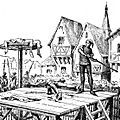Death penalty facts for kids
The death penalty, also known as capital punishment, is when a government or state officially puts someone to death. This usually happens because the person has committed a very serious crime. A crime that can lead to the death penalty is called a capital crime or a capital offense.
In recent centuries, governments have used the death penalty less often. It is a topic that many people disagree about. It causes a lot of discussion and debate around the world.
Contents
What is the Death Penalty?
The death penalty is the most severe punishment a person can receive from the law. It means the government takes away a person's life as a punishment. This is different from being put in prison.
Why is it Used?
Governments use the death penalty for very serious actions that break the law. These are often crimes like murder or terrorism. Some countries, especially those with authoritarian or totalitarian governments, might also use it for less serious crimes. They might even use it if someone says bad things about the government.
Where is the Death Penalty Used?
About one-third of the countries in the world still have laws that allow the death penalty.
Countries That Use It
Some countries that use the death penalty include the United States, the People's Republic of China, Japan, and Iran. These countries believe it is a fair punishment for certain crimes.
Countries That Do Not Use It
Many other countries have stopped using the death penalty. They have "abolished" it. Examples include Canada, Australia, Mexico, and all members of the Council of Europe. These countries believe that the death penalty is wrong.
Images for kids
-
The Christian Martyrs' Last Prayer, by Jean-Léon Gérôme (1883). Roman Circus Maximus.
-
The Death of Socrates (1787), in the Metropolitan Museum of Art in New York City.
-
The burning of Jakob Rohrbach, a leader of the peasants during the German Peasants' War.
-
Emperor Shomu banned the death penalty in Japan in 724.
-
Peter Leopold II abolished the death penalty throughout Tuscany in 1786, making it the first nation in modern history to do so.
-
The Red Guard prisoners are being executed by the Whites in Varkaus, North Savonia, during the 1918 Finnish Civil War.
See also
 In Spanish: Pena de muerte para niños
In Spanish: Pena de muerte para niños












